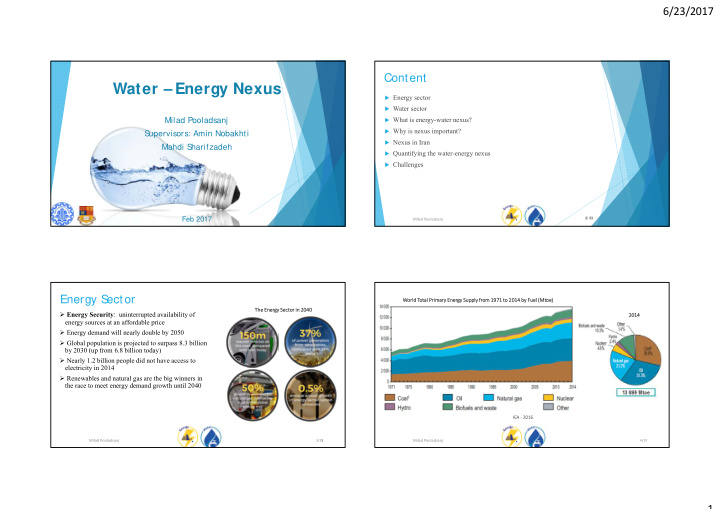



6/23/2017 Content Water – Energy Nexus Energy sector Water sector What is energy-water nexus? Milad Pooladsanj Why is nexus important? S upervisors: Amin Nobakhti Nexus in Iran Mahdi S harifzadeh Quantifying the water-energy nexus Challenges Feb 2017 Milad Pooladsanj 2/ 33 Energy S ector World Total Primary Energy Supply from 1971 to 2014 by Fuel (Mtoe) The Energy Sector in 2040 Energy Security : uninterrupted availability of 2014 energy sources at an affordable price Energy demand will nearly double by 2050 Global population is projected to surpass 8.3 billion by 2030 (up from 6.8 billion today) Nearly 1.2 billion people did not have access to electricity in 2014 Renewables and natural gas are the big winners in the race to meet energy demand growth until 2040 IEA ‐ 2016 Milad Pooladsanj Milad Pooladsanj 3/33 3 4/33 1
6/23/2017 World Total Primary Energy Supply from 1971 to 2014 by Region (Mtoe) Crude Oil Production from 1971 to 2014 by Region (Mt) 2014 2015 • Iran : 6 th Country with 3.9% share of total Milad Pooladsanj Milad Pooladsanj 5/33 6/33 Natural Gas Production from 1971 to 2014 by Region (bcm) Coal Production from 1971 to 2014 by Region (Mt) 2015 2015 • Iran : 3 rd Country with 5.1% share of total Milad Pooladsanj Milad Pooladsanj 7/33 8/33 2
6/23/2017 Nuclear Production from 1971 to 2014 by Region (TWh) Hydro Production from 1971 to 2014 by Region (TWh) 2015 2015 Milad Pooladsanj Milad Pooladsanj 9/33 10/33 World Electricity Generation from 1971 to 2014 by Fuel (TWh) World Electricity Generation from 1971 to 2014 by Region (TWh) 2014 2014 • Iran : 3 rd Country with 5.8% share of electricity generation from oil • Iran : 4 th Country with 3.9% share of electricity generation from natural gas Milad Pooladsanj Milad Pooladsanj 11/33 12/33 3
6/23/2017 Average annual growth in renewable energy capacity and R enewables in Energy S ector biofuels production across the three end‐use sectors Critical for addressing climate change Creating new economic opportunities Providing energy access to billions of people without modern energy service REN21 ‐ 2015 REN21 ‐ 2015 Milad Pooladsanj Milad Pooladsanj 13/33 14/33 Water S ector Percent of population with access to improved water sources (%) Water Security : The capacity of a population to safeguard sustainable access to adequate quantities of and acceptable quality water Water demand will nearly increase 50% by 2050 Climate change , population and water withdrawal intensify water stress Fresh Water Resources Total Water Resources Human Freshwater Use UN Water ‐ 2016 Milad Pooladsanj Milad Pooladsanj 15/33 16/33 4
6/23/2017 Water Withdrawn Per Capita (m3/year) Total renewable resources per capita (m3/inhab/yr) UN Water ‐ 2016 FAO AQUASTAT‐ 2015 Milad Pooladsanj Milad Pooladsanj 17/33 18/33 Proportion of renewable water resources withdrawn Average Annual Precipitation in 2016 (mm/year) FAO AQUASTAT‐ 2015 FAO AQUASTAT‐ 2016 Milad Pooladsanj Milad Pooladsanj 19/33 20/33 5
6/23/2017 What is Energy-Water Nexus? Water and Energy : paramount importance for human livelihood – closely intertwined → must be addressed together we do not appreciate the coupled correlation between them Nucleus of this bond is the reciprocal dependency of resources → how one resource’s demand can steer further demand Milad Pooladsanj Milad Pooladsanj 21/33 22/33 Water use for electricity generation by cooling Why is Energy-Water technology Nexus Important? Water-related risks to energy security Shifts in water availability and quality → reduced reliability of supply Increase in energy demand for water production, treatment and distribution IEA ‐ 2012 Milad Pooladsanj Milad Pooladsanj 23/33 24/33 6
6/23/2017 Amount of Energy Required to provide �� � of Nexus In Iran water safe for human consumption Energy-related risks to water security Limited or unreliable access to affordable energy Renewable energy policies → 5000 MW necessary to extract water electricity production from wind/solar by 2020 Allocation of water resources towards energy Climate change policies → No relevant policy! production → water security risks in other sectors Risks of water contamination from energy- extraction processes Milad Pooladsanj Milad Pooladsanj 25/33 26/33 Iran TPES from 1971 to 2013 by Fuel (Mtoe) Total Production of Renewables (Mtoe) CO2 Emissions from Fuel Combustion (Mt of CO2) TPES/population (toe per capita) Milad Pooladsanj Milad Pooladsanj 27/33 28/33 7
6/23/2017 Quantifying The Water-Energy Nexus Iran Electricity Generation from 1971 to 2013 by Fuel (TWh) A nexus assessment methodology 2013 Qualitative • Providing insights on some of the response options analysis • Quantitative analysis → interlinkages matrix Quantitative • Application of input/output tool assessment • Comparison of interventions Milad Pooladsanj Milad Pooladsanj 30/ 33 29/33 Proposed Method Challenges Multi-objective optimization: deterministic and stochastic Data collection across the interconnected systems of the nexus is crucial Objective 1: Cost objective function information about different elements of the nexus separately Power generation cost data on how the elements of the nexus relate to each other Water Generation cost Accuracy of the data released by different institutions Objective 2: Greenhouse Gas emission objective function Complex optimization problem Climate change feedback: the proposed optimization problem is solved using climate information in future Non-linear: accurate but unsolvable! Comparison with IEA scenarios Current policies scenario Linear: accuracy problem New policies scenario 450 policies scenario Milad Pooladsanj 31/ 33 Milad Pooladsanj 32/ 33 8
6/23/2017 Thanks for your attention Milad Pooladsanj 33/ 33 9
Recommend
More recommend